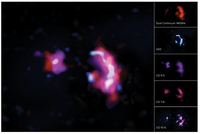Water in the Early Universe
 SPT0311-58 is the most massive infrared luminous system discovered so far during the Epoch of Reionization (EoR). In this paper, the authors present a detailed analysis of the molecular interstellar medium at z = 6.9, through high resolution observations of the CO(6 − 5), CO(7 − 6), CO(10 − 9), [CI](2 − 1), and p-H2O(21,1 − 20,2) lines and dust continuum emission with the Atacama Large Millimeter/submillimeter Array (ALMA). The system consists of a pair of intensely star-forming gravitationally lensed galaxies (labelled West and East). The intrinsic far-infrared luminosity is (16 ± 4)×1012 L⊙ in West and (27 ± 4)×1011 L⊙ in East. The authors model the dust, CO, and [CI] using non-local thermodynamic equilibrium radiative transfer models and estimate the intrinsic gas mass to be (5.4 ± 3.4)×1011 M⊙ in West and (3.1 ± 2.7)×1010 M⊙ in East. They find that the CO spectral line energy distribution in West and East are typical of high-redshift sub-millimeter galaxies (SMGs). The CO-to-H2 conversion factor (αCO) and the gas depletion time scales estimated from the model are consistent with the high-redshift SMGs in the literature within the uncertainties. They find no evidence of evolution of depletion time with redshift in SMGs at z > 3. This is the most detailed study of molecular gas content of a galaxy in the EoR to-date, with the most distant detection of H2O in a galaxy without any evidence for active galactic nuclei in the literature.
SPT0311-58 is the most massive infrared luminous system discovered so far during the Epoch of Reionization (EoR). In this paper, the authors present a detailed analysis of the molecular interstellar medium at z = 6.9, through high resolution observations of the CO(6 − 5), CO(7 − 6), CO(10 − 9), [CI](2 − 1), and p-H2O(21,1 − 20,2) lines and dust continuum emission with the Atacama Large Millimeter/submillimeter Array (ALMA). The system consists of a pair of intensely star-forming gravitationally lensed galaxies (labelled West and East). The intrinsic far-infrared luminosity is (16 ± 4)×1012 L⊙ in West and (27 ± 4)×1011 L⊙ in East. The authors model the dust, CO, and [CI] using non-local thermodynamic equilibrium radiative transfer models and estimate the intrinsic gas mass to be (5.4 ± 3.4)×1011 M⊙ in West and (3.1 ± 2.7)×1010 M⊙ in East. They find that the CO spectral line energy distribution in West and East are typical of high-redshift sub-millimeter galaxies (SMGs). The CO-to-H2 conversion factor (αCO) and the gas depletion time scales estimated from the model are consistent with the high-redshift SMGs in the literature within the uncertainties. They find no evidence of evolution of depletion time with redshift in SMGs at z > 3. This is the most detailed study of molecular gas content of a galaxy in the EoR to-date, with the most distant detection of H2O in a galaxy without any evidence for active galactic nuclei in the literature.
Image Caption: Composite showing the H2O, CO, and dust emission from a merging galaxy at z = 6.9.
Publication: Sreevani Jarugula (University of Illinois) et al., Molecular Line Observations in Two Dusty Star-Forming Galaxies at z = 6.9, Astrophysical Journal (accepted), arXiV:2108.11319.
NRAO Press Release: ALMA Scientists Detect Signs of Water in a Galaxy Far, Far Away




Connect with NRAO